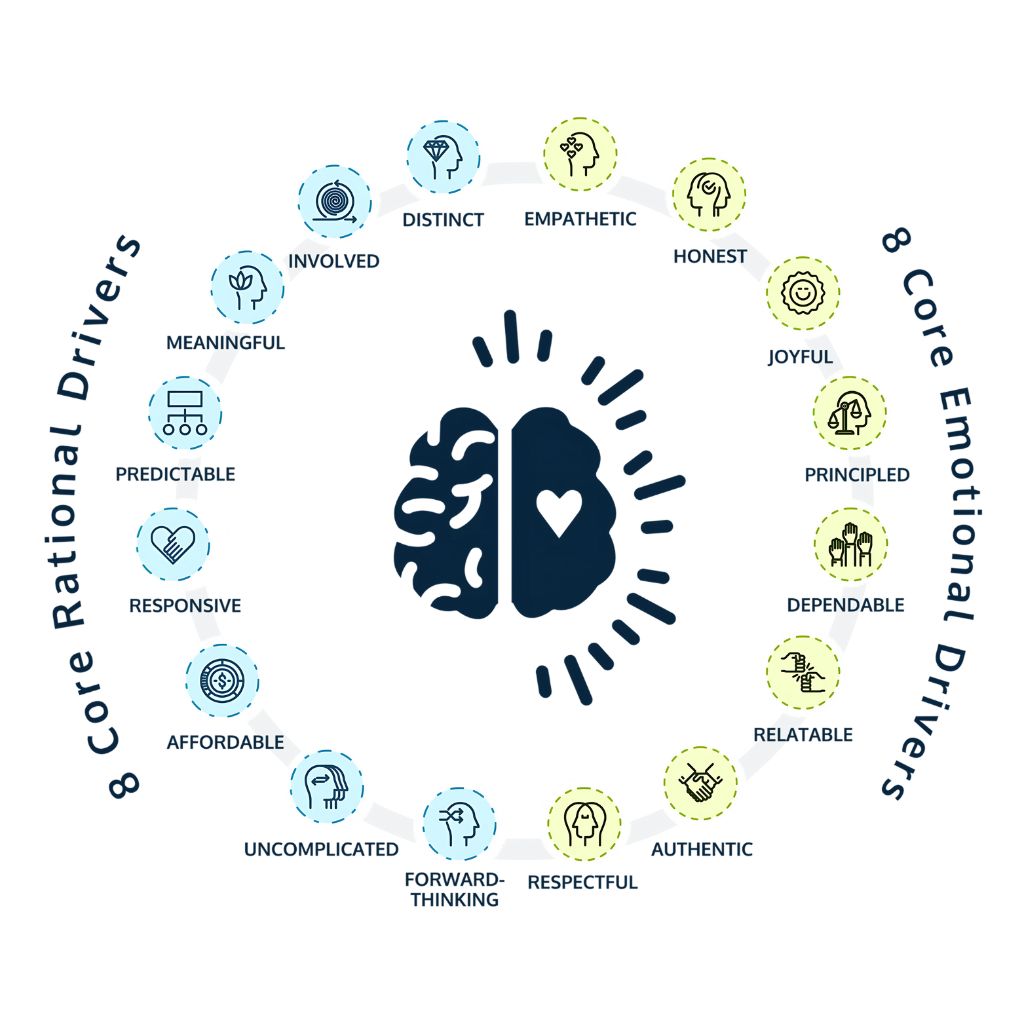Measurement Through Survey
Apex measures motivation using a standardized, science-backed survey instrument designed to quantify the underlying psychological drivers behind customer behavior. Our survey methodology draws from established behavioral science and was developed in collaboration with leading academic institutions including Harvard University, Columbia University, and the University of Western Australia. At the heart of the Apex Customer Survey is a set of 16 motivational drivers:
Core Elements
Every survey includes:1
A randomized grid of statements linked to our 16 motivational drivers
See Motivator Ratings Grid below.
2
Questions that measure advocacy and intent to repurchase.
See Behavioral Intent below.
3
Open-ended prompts to gather descriptive experience feedback.
See Experience Feedback below.
4
Any other contextual questions that provide segmentation (e.g. age, gender, income, etc.).
See Other Data Points below.
Tailoring for Your Context
Before launch, we work with you to understand:- Your customer journey and most common interaction points
- Strategic goals for the model (e.g. retention, growth, brand trust)
- Competitive context, audience nuances, and existing research
Example Standard Survey
The Apex Customer Experience Survey is designed to capture both quantitative and qualitative insights related to how customers perceive and experience a brand. It serves as the foundation for measuring the 16 motivational drivers that inform Apex’s predictive models.Question Types
1. Motivator Ratings Grid (Closed-Ended)
Respondents are asked to rate their level of agreement with a series of statements using a 7-point Likert scale:Scale:
1 = Completely disagree
2, 3, 4 = Neither agree nor disagree
5, 6, 7 = Completely agree
1 = Completely disagree
2, 3, 4 = Neither agree nor disagree
5, 6, 7 = Completely agree
There is no “I don’t know” option to ensure participants provide their best estimate.
Statements are randomized and linked to specific Apex motivational drivers.
| # | Motivator | Survey Statement |
|---|---|---|
| 1 | uncomplicated | Dealing with BRAND is easy. |
| 2 | responsive | BRAND’s staff are accessible and helpful. |
| 3 | respectful | BRAND treats me like a human being. |
| 4 | relatable | I see myself reflected in the BRAND. |
| 5 | principled | BRAND always makes up for any mistakes. |
| 6 | predictable | I can always look forward to a consistent experience from BRAND. |
| 7 | meaningful | BRAND stands for something more than their products and services. |
| 8 | joyful | Dealing with BRAND always puts a smile on my face. |
| 9 | involved | BRAND helps make my community better. |
| 10 | honest | BRAND is an open and transparent organization. |
| 11 | forward-thinking | BRAND is innovative. |
| 12 | empathetic | BRAND understands me. |
| 13 | distinct | BRAND offers unique products and services. |
| 14 | dependable | I feel like BRAND has my back. |
| 15 | authentic | BRAND always represents their core beliefs in their actions. |
| 16 | affordable | BRAND’s fees are not an issue for me. |
2. Behavioral Intent (Closed-Ended)
Participants also rate statements about their behavioral intentions, such as:| # | Target | Survey Statement |
|---|---|---|
| 17 | advocacy | I would readily encourage others to use BRAND for the products and services they provide. |
| 18 | intent | I plan on turning to BRAND first the next time I need what they provide. |
These items are used to correlate motivational perceptions with intent to advocate or repurchase.
3. Experience Feedback (Open-Ended)
Participants provide detailed written responses about:| # | Purpose | Survey Statement |
|---|---|---|
| 19 | Recent Interaction | Describe your most recent interaction with BRAND. What was the nature of your interaction, what went well, and what didn’t go so well? Please be as descriptive as possible in your response. |
| 20 | Overall Perception | Describe your full perspective on BRAND as a company. Include any opinions on what their company represents, how they operate, and how the brand makes you feel. Please provide as much detail as possible. Most people provide 2-3 sentences. |
These responses are analyzed through AI-powered text analysis and linked to the motivational dataset for deeper interpretation.
4. Other Data Points
In addition to the motivational items, we often add a small number of structured questions to enable segmentation. These may include:- Demographics (age, gender, household income)
- Geographics (region, postal code, urban/rural classification)
- Behavioral (channel used, purchase frequency, recency)
- Role or Relationship (e.g. tenure, account type, subscription level)
One-pager Summary
Survey Deployment
Because we are not a survey platform, we are agnostic to the method of survey deployment. We can talk about your existing tools and processes and help you find the best fit for your needs. Some options include:- We handle everything turn-key
- Our survey is inserted into an existing workflow or brand tracker cadence you have
- We purchase survey sample from one of our trusted partners

